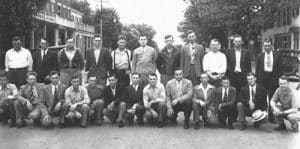Monroe County 1940-1960: wars, a bridge and parks

Pictured, 24 of Monroe County’s finest young men assemble for a group photo outside the draft center on Main Street in Waterloo on June 23, 1942. (submitted photo)
(This is the next monthly installment of our series looking into the 200-year history of Monroe County in honor of its Bicentennial. This article examines the years 1940 to 1960.)
The two decades from 1940 to 1960 were times of great tumult for Monroe County. Several previous Republic-Times features have told of personal impacts on citizens engaged in World War II and the Korean Conflict. And we saw the budding days of America’s involvement in Vietnam at the end of this time.
While the scale of WWII was immense – nearly 13 million service members, mostly men – were drawn from a population of some 130 million – the war had severe impacts on virtually everyone.
But the impact of WWII was felt by all at home, as well. For those who didn’t experience it, or who maybe don’t even hear of it any more, here were some examples.
We had a draft. In fact, we had a military draft for the entire two decades. You didn’t have to volunteer. When you turned 18, you were placed on a list for possible call up. A letter from the draft board was not an invitation. It was a lawful order to report for service. Many farmers were exempt because they were critically needed to feed our forces and nation. And war industry factories were clamoring for help.
For those who stayed at home, shortly after America’s involvement in WWII began on Dec. 7, 1941, rationing followed. Rationing was a process by which citizens were restricted from buying certain food items like meat, sugar, and much of what was needed to feed vast numbers of troops overseas.
Other things were rationed, like gasoline, replacement tires for cars and trucks and even soap. More items, like many fabrics, simply were unavailable.
Soon after WWII started, all auto production ceased as car manufacturers turned to making military trucks, tanks and war planes. Scrap was collected to be turned into war machinery. Many antique cars and machines are rare today because the large majority of them were melted for conversion into ships, planes and tanks.
Rationing didn’t end, nor did new cars reappear, until 1946. And of course, many mostly young men went to war and never returned alive.
Turning to Monroe County specifically, the population grew from 13,282 in 1940 to 15,507 in 1960.
The first Jefferson Barracks Bridge was built in 1941. It was ostensibly built to support movement between Scott Air Force Base and Jefferson Barracks Hospital. It was a single span, two-lane road, and a toll was charged to cross.
It also, of course, greatly expanded cross-river movement, which had previously been provided regionally at St. Louis.
In 1948, two groups that are still strong elements in Monroe County got their starts.
The Extension Homemakers – also tagged the “Helpful Hannahs” – was formed then as an outgrowth of various groups that helped people lead higher quality lives during the depression and later during WWII.
And the Monroe County Fair Association that just finished another extremely successful county fair was established. For those who don’t remember, the fair was once held on property surrounding today’s intersection of Route 3 and Park Street. Obviously, Route 3 was not there at that time.
The period of 1950-1953 was a time of another large scale military conflict, this time in Korea. Although this would never become a formally declared war, the opening round of actual Cold War fighting eventually cost some 5 million lives, including 36,516 Americans. Another outgrowth of the growing tensions between Communist nations and the American-led post-war coalition was construction of the Nike Anti-aircraft Missile Base east of Hecker in 1959. Unknown to many in the county, the base supported nuclear-armed Nike Hercules missiles to defend St. Louis against potential Soviet bomber attacks.
In 1955, there came the first hints of what would become an even costlier war for America, in Vietnam – but that’s a subject for the next edition of this review of Monroe County history.
The end of the era was a time of rapid expansion of parks across Monroe County, which we all still enjoy today. The year 1958 saw the establishment of Columbia’s Bolm-Schuhkraft Park. A year later, Valmeyer’s Borsch Memorial Park came into existence. And in 1960, to round out the two-decade period, Waterloo’s Konarcik Park was opened to recreational activities.
We still celebrate high school reunions for citizens graduating at the end of this time, and a lot of older citizens share memories often at fast food restaurant breakfasts as well as family gatherings.
Readers today can get a lot of great stories first hand from their elders, but we are going to continue to observe and celebrate the 200 years of Monroe County as we move toward the conclusion of our Bicentennial celebration.








